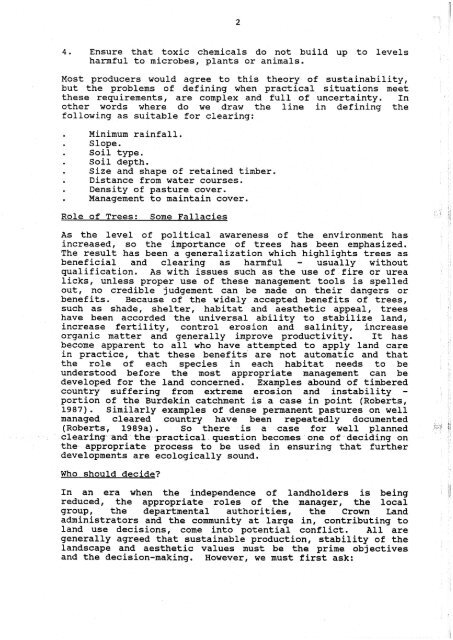soil-conservation-people-religion-and-land.pdf - South West NRM
soil-conservation-people-religion-and-land.pdf - South West NRM
soil-conservation-people-religion-and-land.pdf - South West NRM
You also want an ePaper? Increase the reach of your titles
YUMPU automatically turns print PDFs into web optimized ePapers that Google loves.
4. Ensure that toxic chemicals do not build up to levels<br />
harmful to microbes, plants or animals.<br />
Most producers would agree to this theory of sustainability,<br />
but the problems of defining when practical situations meet<br />
these requirements, are complex <strong>and</strong> full of uncertainty. In<br />
other words where do we draw the line in defining the<br />
following as suitable for clearing:<br />
Minimum rainfall.<br />
Slope.<br />
Soil type.<br />
Soil depth.<br />
Size <strong>and</strong> shape of retained timber.<br />
Distance from water courses.<br />
Density of pasture cover.<br />
Management to maintain cover.<br />
Role of Trees: Some Fallacies<br />
As the level of political awareness of the environment has<br />
increased, so the importance of trees has been emphasized.<br />
The result has been a generalization which highlights trees as<br />
beneficial <strong>and</strong> clearing as harmful - usually without<br />
qualification. As with issues such as the use of fire or urea<br />
licks, unless proper use of these management tools is spelled<br />
out, no credible judgement can be made on their dangers or<br />
benefits. Because of the widely accepted benefits of trees,<br />
such as shade, shelter, habitat <strong>and</strong> aesthetic appeal, trees<br />
have been accorded the universal ability to stabilize l<strong>and</strong>,<br />
increase fertility, control erosion <strong>and</strong> salinity, increase<br />
organic matter <strong>and</strong> generally improve productivity.<br />
It has<br />
become apparent to all who have attempted to apply l<strong>and</strong> care<br />
in practice, that these benefits are not automatic <strong>and</strong> that<br />
the role of each species in each habitat needs to be<br />
understood before the most appropriate management can be<br />
developed for the l<strong>and</strong> concerned. Examples abound of timbered<br />
country suffering from extreme erosion <strong>and</strong> instability -<br />
portion of the Burdekin catchment is a case in point (Roberts,<br />
1987). Similarly examples of dense permanent pastures on well<br />
managed cleared country have been repeatedly documented<br />
(Roberts, 1989a) . So there is a case for well planned<br />
clearing- <strong>and</strong> the practical question becomes one of deciding on<br />
the. appropriate process to be used in ensuring that further<br />
developments are ecologically sound.<br />
Who should decide?<br />
In an era when the independence of l<strong>and</strong>holders is being<br />
reduced, the appropriate roles of the manager, the local<br />
group, the departmental authorities, the Crown L<strong>and</strong><br />
administrators <strong>and</strong> the community at large in, contributing to<br />
l<strong>and</strong> use decisions, come into potential conflict. All are<br />
generally agreed that sustainable production, stability of the<br />
l<strong>and</strong>scape <strong>and</strong> aesthetic values must be the prime objectives<br />
<strong>and</strong> the decision-making. However, we must first ask:
















